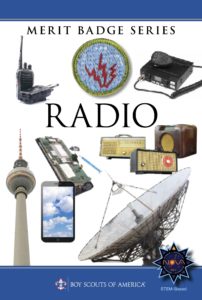The Radio Merit Badge requirements were updated effective January 1, 2017. Here’s a quick review of the changes:
A new option for the Radio Merit Badge is Amateur Radio Direction Finding. This combines orienteering and foxhunting and opens a new interactive component to this program.
In addition, cellular telephone topics have been added along with different types of radio modulation. Key requirement changes were dropping open, closed, and short circuits as well as schematic symbols and components as these are covered in the Electricity and Electronics merit badges.
Other revisions include: minor edits and reordering of requirements in the Amateur Radio option; Radio Broadcasting option now includes Internet streaming, regulations, and power levels; Medium Wave and Shortwave Listening option includes both types of listening as well as listening via streaming services on your smart phone.
Frequently Asked Questions
Where can I find the requirements?
The latest Radio merit badge requirements are at:
http://www.scouting.org/filestore/Merit_Badge_ReqandRes/Radio.pdf
The previous requirements are at:
http://www.scouting.org/filestore/Merit_Badge_ReqandRes/Radio_previous.pdf
You can find all BSA official merit badge requirements in the merit badge counselor guidelines at:
http://www.scouting.org/Home/BoyScouts/GuideforMeritBadgeCounselors/IntroToMeritBadges.aspx
Has the pamphlet been revised?
 The pamphlet has been updated to address the new requirements. It is order number 642986 with copyright 2017 and designated as the 2017 printing. Make sure you are buying the current version. Here’s the BSA Supply listing — Radio Merit Badge. Please note that if the pamphlet is out of stock at BSA Supply, they will remove it’s listing from their website. Either wait it out or work with your Scout Shop to find them.
The pamphlet has been updated to address the new requirements. It is order number 642986 with copyright 2017 and designated as the 2017 printing. Make sure you are buying the current version. Here’s the BSA Supply listing — Radio Merit Badge. Please note that if the pamphlet is out of stock at BSA Supply, they will remove it’s listing from their website. Either wait it out or work with your Scout Shop to find them.
What has changed?
A new option for the Radio Merit Badge is Amateur Radio Direction Finding. This combines orienteering and foxhunting and opens a new interactive component to this program.
In addition, cellular telephone topics have been added along with different types of radio modulation. Key requirement changes were dropping open, closed, and short circuits as well as schematic symbols and components as these are covered in the Electricity and Electronics merit badges.
Other revisions include: minor edits and reordering of requirements in the Amateur Radio option; Radio Broadcasting option now includes Internet streaming, regulations, and power levels; Medium Wave and Shortwave Listening option includes both types of listening as well as listening via streaming services on your smart phone.
What training resources are available?
Phil Westover, WA7URV, has developed the slide decks for the K2BSA 2017 National Scout Jamboree merit badge classes. You can download them at the Jamboree Radio Merit Badge page. Thanks, Phil.
Gary Wilson, K2GW, has also developed prototype slide decks organized into three one-hour modules. You can download them here:
Printer Friendly PDFs:
- Radio MB Module 1 04 Dec2017 – Split
- Radio MB Module 2 04 Dec2017 -Split
- Radio MB Module 3 29 July 2021 -Split
These slide decks, and all the material on this website, have been provided for your use in Radio Scouting activities. You are welcome to download and modify in whole or in part for your Scouting activities.
What’s the difference between requirements and options?
For the Radio Merit Badge there are 8 requirements and 4 options. Everyone must complete the first eight requirements. Then they select an option for the rest of their Radio Merit Badge work. Within each option are also several requirements. Here’s how it looks:
What if I have suggestions for the next revision?
The best time to start the next project is the same time you finished the last one. As you discover things you’d like to see done differently in future revisions, please send your suggestions to the BSA Merit Badge Maintenance Task Force at merit.badge@scouting.org
How do I become a Merit Badge Counselor?
You’ll need to register with your local Scout council, which can be found via the locator at https://www.scouting.org/discover/local-council-locator/ Then you’ll need to complete Youth Protection Training and complete the application for Adult Membership. Then you’ll sign up as a merit badge counselor. More information is available at https://www.scouting.org/programs/boy-scouts/mb-counselor-guide/
Acknowledgements for the revised requirements
Thanks to the following for their work on the revised requirements and pamphlet manuscript:
- BSA National Radio Scouting Committee for their work in making suggestions and reviewing the book: Mark Abramowitz, NT3V; Bill Bode, N4WEB; Doug Cook, KX5DC; Ed Dudley, WA4ISA; Christian Ingerslev, AB2SN; Keith Kaiser, WA0TJT; Frank Kisselbach, W7PAQ; Frank Krizan, K5HS; Grant Laughlin, W5XJ; Russ Mickiewicz, N7QR; Brian Walker, K9BKW; Gary Wilson, K2GW; Ron Wood, K0BRO.
- Skip Arey, N2EI, for Medium Wave and Shortwave Listening review and update.
- Michael Thorp for Radio Broadcasting review and revision recommendations.
- For ARDF requirements development and manuscript suggestions and review: Brian Coleman, KB0MAP; Dick Arnett, WB4SUV; Joe Moell, K0OV; Harley Leach, KI7XF; Marvin Johnston, KE6HTS.
- Jim Wilson, K5ND, coordinated all the recommended changes and wrote the manuscript.

